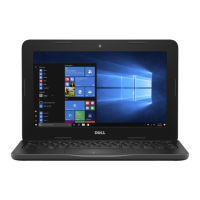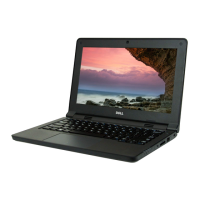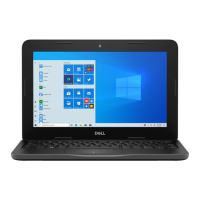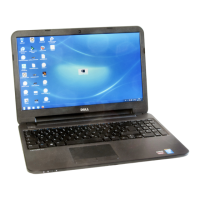Do you have a question about the Dell Latitude 3189 and is the answer not in the manual?
Guidelines to protect your computer from potential damage and ensure personal safety.
Steps to prepare the computer before performing internal disassembly or maintenance.
Procedure for safely shutting down the computer operating system before maintenance.
Steps to reconnect devices and ensure the computer is ready for use after maintenance.
List of tools required for component removal and installation procedures.
Step-by-step guide to remove and install the microSD card from the computer.
Procedures for removing and installing the computer's base cover.
Safety precautions and procedures for removing and installing the computer's battery.
Procedures for removing and installing the computer's keyboard.
Procedures for removing and installing the M.2 Solid State Drive (SSD).
Procedures for removing and installing the power switch board.
Procedures for removing and installing the computer's audio board.
Procedures for removing and installing the power connector port.
Procedures for removing and installing the coin cell battery.
Procedures for removing and installing the computer's speakers.
Procedures for removing and installing the computer's touchpad panel.
Procedures for removing and installing the computer's display assembly.
Procedures for removing and installing the computer's display back cover.
Procedures for removing and installing the computer's system board.
Procedures for removing and installing the world facing camera.
Procedures for removing and installing the computer's palm rest.
Information about the 65W power adapter and laptop processors, with identification steps.
How to check processor usage using Task Manager and Resource Monitor.
Information on chipsets and Intel HD Graphics, and how to identify them.
Instructions for identifying display adapters and changing screen resolution.
Adjusting screen brightness, connecting external displays, and verifying system memory.
Testing memory with ePSA and identifying hard drives in Windows and BIOS.
Details on graphics options, hard drive support, and USB features overview.
Details on USB speed, applications, and compatibility with older USB versions.
Explanation of HDMI 1.4 features, advantages, and audio support.
Details on the Realtek ALC3246 audio codec and camera specifications.
Instructions on how to start and use the camera application.
How to access and use the one-time boot menu for diagnostics and setup.
Explanation of keys used for navigation within the System Setup utility.
Overview of the System Setup utility and step-by-step guide to access it.
Details on primary hardware features and configuration options available in System Setup.
Options for configuring drives, USB, audio, and other system devices.
Options for adjusting LCD brightness and video settings.
Options for setting administrator, system, and HDD passwords.
Options for enabling or disabling Secure Boot and managing security keys.
Options to configure processor performance and manage power settings.
Options for managing system wake-up, sleep states, and battery charging.
Options for boot behavior, wireless devices, and system maintenance settings.
Options for system logs, SupportAssist, and instructions for updating the BIOS.
Information and procedures for creating, assigning, and managing system and setup passwords.
Procedure to delete or change existing system and setup passwords.
Details on chipset, DRAM, Flash EPROM, and PCIe bus specifications.
Specifications for Intel Celeron N3350 and Pentium N4200 processors.
Specifications for memory capacity, type, speed, and maximum memory.
Specifications for supported M.2 SATA SSD drive types.
Specifications for audio types, controller, conversion, interfaces, and speakers.
Specifications for GPU cards and external display support.
Specifications for primary and world-facing cameras, including resolution and viewing angles.
Specifications for wireless communication features like WLAN and Bluetooth.
Specifications for audio, video, USB ports, memory card reader, and docking.
Specifications for the number of keys on the keyboard.
Specifications for the touchpad's active area dimensions.
Specifications for battery type, capacity, dimensions, voltage, and temperature ranges.
Specifications for AC adapter type, input voltage, current, and frequency.
Physical dimensions and weight of the laptop.
Specifications for operating and storage temperature, humidity, and altitude.
Overview of the ePSA diagnostics for checking hardware.
Instructions on how to initiate and run the ePSA diagnostics.
Procedure for resetting the Real Time Clock (RTC) to resolve boot issues.
Instructions on how to contact Dell for sales, technical support, or customer service.
Guidelines to protect your computer from potential damage and ensure personal safety.
Steps to prepare the computer before performing internal disassembly or maintenance.
Procedure for safely shutting down the computer operating system before maintenance.
Steps to reconnect devices and ensure the computer is ready for use after maintenance.
List of tools required for component removal and installation procedures.
Step-by-step guide to remove and install the microSD card from the computer.
Procedures for removing and installing the computer's base cover.
Safety precautions and procedures for removing and installing the computer's battery.
Procedures for removing and installing the computer's keyboard.
Procedures for removing and installing the M.2 Solid State Drive (SSD).
Procedures for removing and installing the power switch board.
Procedures for removing and installing the computer's audio board.
Procedures for removing and installing the power connector port.
Procedures for removing and installing the coin cell battery.
Procedures for removing and installing the computer's speakers.
Procedures for removing and installing the computer's touchpad panel.
Procedures for removing and installing the computer's display assembly.
Procedures for removing and installing the computer's display back cover.
Procedures for removing and installing the computer's system board.
Procedures for removing and installing the world facing camera.
Procedures for removing and installing the computer's palm rest.
Information about the 65W power adapter and laptop processors, with identification steps.
How to check processor usage using Task Manager and Resource Monitor.
Information on chipsets and Intel HD Graphics, and how to identify them.
Instructions for identifying display adapters and changing screen resolution.
Adjusting screen brightness, connecting external displays, and verifying system memory.
Testing memory with ePSA and identifying hard drives in Windows and BIOS.
Details on graphics options, hard drive support, and USB features overview.
Details on USB speed, applications, and compatibility with older USB versions.
Explanation of HDMI 1.4 features, advantages, and audio support.
Details on the Realtek ALC3246 audio codec and camera specifications.
Instructions on how to start and use the camera application.
How to access and use the one-time boot menu for diagnostics and setup.
Explanation of keys used for navigation within the System Setup utility.
Overview of the System Setup utility and step-by-step guide to access it.
Details on primary hardware features and configuration options available in System Setup.
Options for configuring drives, USB, audio, and other system devices.
Options for adjusting LCD brightness and video settings.
Options for setting administrator, system, and HDD passwords.
Options for enabling or disabling Secure Boot and managing security keys.
Options to configure processor performance and manage power settings.
Options for managing system wake-up, sleep states, and battery charging.
Options for boot behavior, wireless devices, and system maintenance settings.
Options for system logs, SupportAssist, and instructions for updating the BIOS.
Information and procedures for creating, assigning, and managing system and setup passwords.
Procedure to delete or change existing system and setup passwords.
Details on chipset, DRAM, Flash EPROM, and PCIe bus specifications.
Specifications for Intel Celeron N3350 and Pentium N4200 processors.
Specifications for memory capacity, type, speed, and maximum memory.
Specifications for supported M.2 SATA SSD drive types.
Specifications for audio types, controller, conversion, interfaces, and speakers.
Specifications for GPU cards and external display support.
Specifications for primary and world-facing cameras, including resolution and viewing angles.
Specifications for wireless communication features like WLAN and Bluetooth.
Specifications for audio, video, USB ports, memory card reader, and docking.
Specifications for the number of keys on the keyboard.
Specifications for the touchpad's active area dimensions.
Specifications for battery type, capacity, dimensions, voltage, and temperature ranges.
Specifications for AC adapter type, input voltage, current, and frequency.
Physical dimensions and weight of the laptop.
Specifications for operating and storage temperature, humidity, and altitude.
Overview of the ePSA diagnostics for checking hardware.
Instructions on how to initiate and run the ePSA diagnostics.
Procedure for resetting the Real Time Clock (RTC) to resolve boot issues.
Instructions on how to contact Dell for sales, technical support, or customer service.
| Form factor | Convertible (Folder) |
|---|---|
| Product type | Hybrid (2-in-1) |
| Product color | Black |
| Market positioning | Educational |
| Tjunction | 105 °C |
| Processor cache | 2 MB |
| Processor cores | 4 |
| Processor model | N4200 |
| System bus rate | - GT/s |
| Processor family | Intel® Pentium® |
| Processor series | Intel Pentium Processor N4000 Series for Mobile |
| Processor socket | BGA 1296 |
| Processor codename | Apollo Lake |
| Processor frequency | 1.1 GHz |
| Processor cache type | L2 |
| Processor lithography | 14 nm |
| Processor manufacturer | Intel |
| PCI Express slots version | 2.0 |
| Processor boost frequency | 2.5 GHz |
| Processor operating modes | 64-bit |
| ECC supported by processor | No |
| PCI Express configurations | 1x2, 1x2+2x1 |
| Thermal Design Power (TDP) | 6 W |
| Scenario Design Power (SDP) | 4 W |
| Maximum number of PCI Express lanes | 6 |
| Internal memory | 4 GB |
| Memory clock speed | 1600 MHz |
| Memory form factor | On-board |
| Internal memory type | LPDDR3-SDRAM |
| SSD capacity | The Solid State Drive's storage capacity in Gigabytes. |
| SSD interface | SATA |
| Storage media | SSD |
| SSD form factor | M.2 |
| Card reader integrated | Yes |
| Total storage capacity | 128 GB |
| Compatible memory cards | MicroSD (TransFlash) |
| Number of SSDs installed | 1 |
| Display diagonal | 11.6 \ |
| Touch technology | Multi-touch |
| Touchscreen type | Capacitive |
| Display resolution | 1366 x 768 pixels |
| Native aspect ratio | 16:9 |
| Number of execution units | 18 |
| On-board graphics card ID | 0x5A84 |
| Discrete graphics card model | Not available |
| On-board graphics card model | Intel® HD Graphics 505 |
| Maximum on-board graphics card memory | 8 GB |
| On-board graphics card base frequency | 200 MHz |
| On-board graphics card burst frequency | 750 MHz |
| Audio chip | Realtek ALC3246 |
| Speaker power | 2 W |
| Number of built-in speakers | 2 |
| Front camera resolution | 1280 x 720 pixels |
| Rear camera resolution (numeric) | 1 MP |
| Front camera resolution (numeric) | 5 MP |
| Wi-Fi standards | 802.11a, Wi-Fi 5 (802.11ac), 802.11b, 802.11g, Wi-Fi 4 (802.11n) |
| Bluetooth version | 4.2 |
| Docking connector | - |
| Charging port type | DC-in jack |
| USB 2.0 ports quantity | 0 |
| Pointing device | Touchpad |
| Trial software | McAfee, Microsoft Office |
| Battery capacity | 42 Wh |
| Number of battery cells | 3 |
| AC adapter power | 65 W |
| AC adapter frequency | 50 - 60 Hz |
| AC adapter input voltage | 100 - 240 V |
| Cable lock slot type | Noble |
| Operating altitude | 0 - 3048 m |
| Non-operating altitude | 0 - 10668 m |
| Storage temperature (T-T) | -40 - 65 °C |
| Operating temperature (T-T) | 0 - 35 °C |
| Storage relative humidity (H-H) | 5 - 95 % |
| Operating relative humidity (H-H) | 10 - 90 % |
| Sustainability certificates | ENERGY STAR |
| Processor ARK ID | 95592 |
| Processor package size | 24 x 31 mm |
| Intel Identity Protection Technology version | 1.00 |
| Intel Small Business Advantage (SBA) version | 0.00 |
| Depth | 207.9 mm |
|---|---|
| Width | 303.8 mm |
| Height | 20.75 mm |
| Weight | 1474.9 g |











